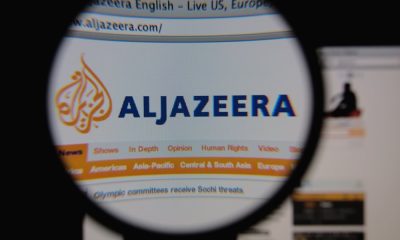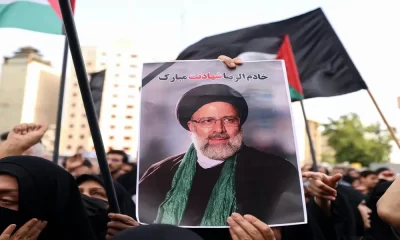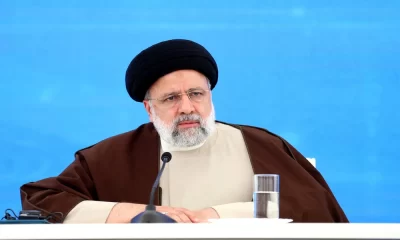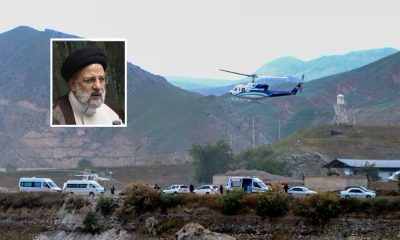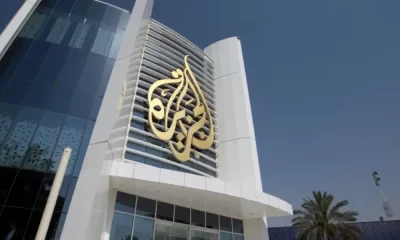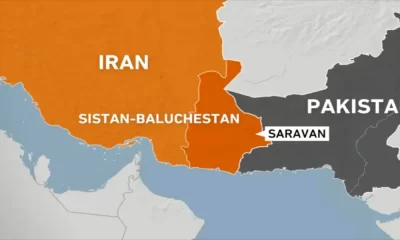Middle East
Israel Bombs Iranian Embassy in Syria Killing Top Commander

On Monday, a suspected Israeli warplane dropped a bomb on Iran’s embassy in Syria, marking a significant escalation in Israel’s war with its regional foes. Tehran reported that the strike killed seven military advisers, including three senior commanders.
Reuters reporters on the scene in Damascus’ Mezzeh area observed rescue workers clambering atop the rubble of a wrecked building within the diplomatic grounds, next to the main embassy. Outside were emergency trucks parked. An Iranian flag hung from a post near the rubble.
The Syrian foreign and interior ministers were also seen at the scene. “We strongly condemn this atrocious terrorist attack that targeted the Iranian consulate building in Damascus and killed a number of innocents,” Syria’s Foreign Minister Faisal Mekdad stated.
Israel’s military has increased its bombings in Syria targeting Iran’s Islamic Revolutionary Guard Corps and the Iranian-backed Lebanese armed group Hezbollah, both of which support Syrian President Bashar al-Assad’s regime.
Israel launched its first attack on the massive embassy compound on Monday, Reuters reported.
Israel normally does not mention its soldiers’ attacks on Syria. When asked about the strike, an Israeli military official stated, “We do not comment on reports in the foreign media”.
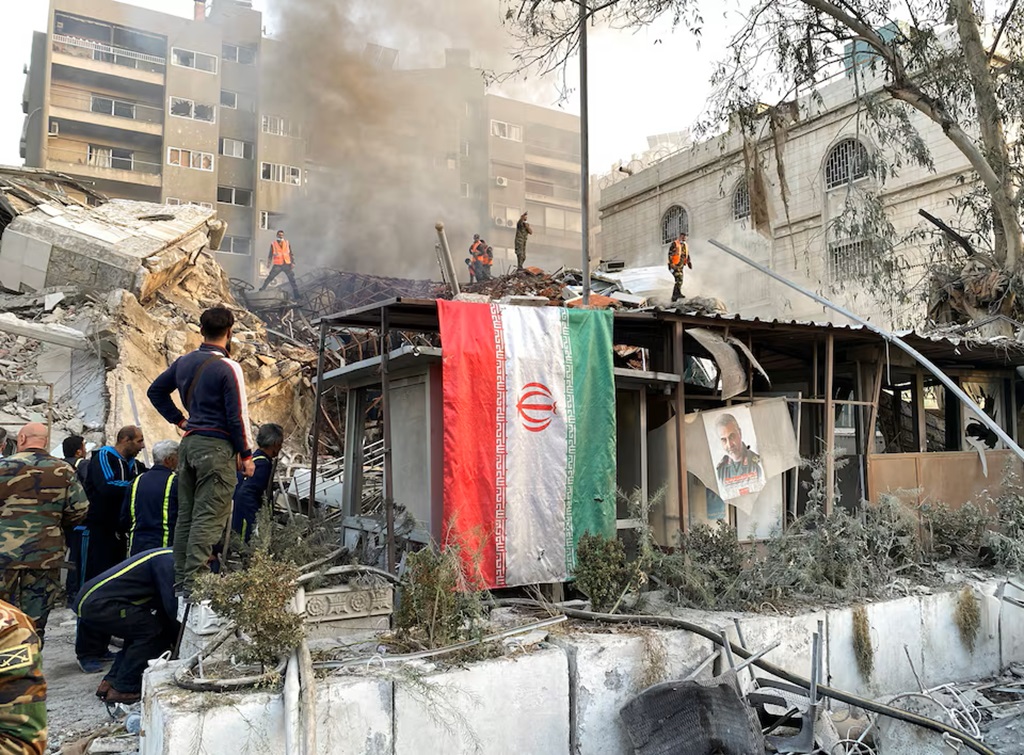
Iran’s envoy to Syria, Hossein Akbari, who was unharmed, told Iranian state television that five to seven individuals, including diplomats, were killed and that Tehran’s response would be “harsh”.
Iran’s Revolutionary Guards said in a statement that the strike killed seven military advisers, including Mohammad Reza Zahedi, a senior commander in the IRGC’s Quds Force, an elite overseas espionage and paramilitary branch.
Iranian official television reported that Tehran suspected Zahedi was the intended target of the strike. His deputy and another senior commander were also slain, as did four others.
According to the New York Times, four unnamed Israeli officials acknowledged that Israel carried out the strike.
Iran’s Arabic language According to Al Alam Television, Zahedi was a Syrian military adviser who led the Quds Force in both Lebanon and Syria until 2016.
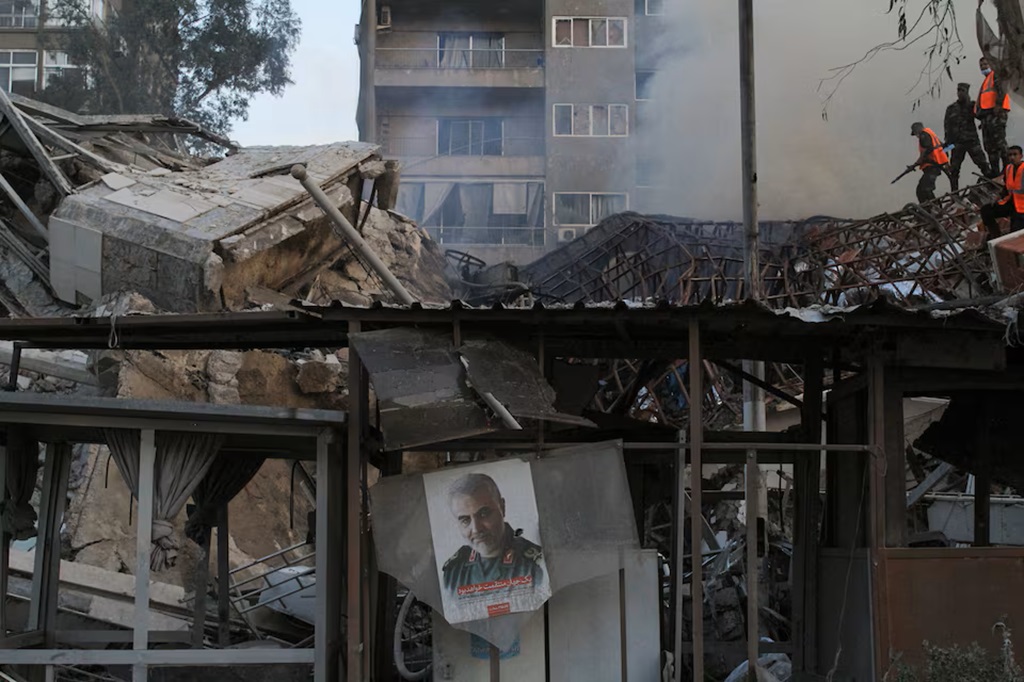
According to Syrian official media, Israel conducted an attack on the Iranian embassy from the occupied Golan Heights, and Syria responded with an air defense system that shot down some missiles.
The Iranian ambassador stated that the strike hit a consular building within the embassy compound, with his house on the top two levels.
The White House did not immediately respond to a request for comment.
At a regular news conference, State Department spokesperson Matthew Miller stated that the US is still “concerned about anything that would be escalatory or cause an increase in conflict in the region.”
Miller said he did not anticipate it to affect talks to liberate Israeli prisoners held by Iran-backed Hamas.
Hamas and Houthi spokespeople, an Iran-backed Yemeni organization that has targeted vessels in the Gulf of Aden since mid-November, condemned the Damascus strike.
On Friday, Israel launched its bloodiest strikes in months on northern Syria’s Aleppo region, killing a senior Hezbollah fighter in Lebanon.
It has also repeatedly targeted airports in Aleppo and Damascus in an attempt to disrupt Iran’s weapons deliveries to its proxies.
The Israeli military stated on Monday that it has also stopped advanced weapons, such as shrapnel charges and anti-tank mines, from being transported into the West Bank from Iran. It said that the weapons were discovered during an operation against a Hezbollah and IRGC agent based in Lebanon.
Source: Reuters
Israeli Far Right Furious Over 68 Gaza Orphans Being Evacuated
Israeli Far Right Furious Over 68 Gaza Orphans Being Evacuated

Middle East
US Navy Struggles to Combat Yemen’s Houthi Rebels
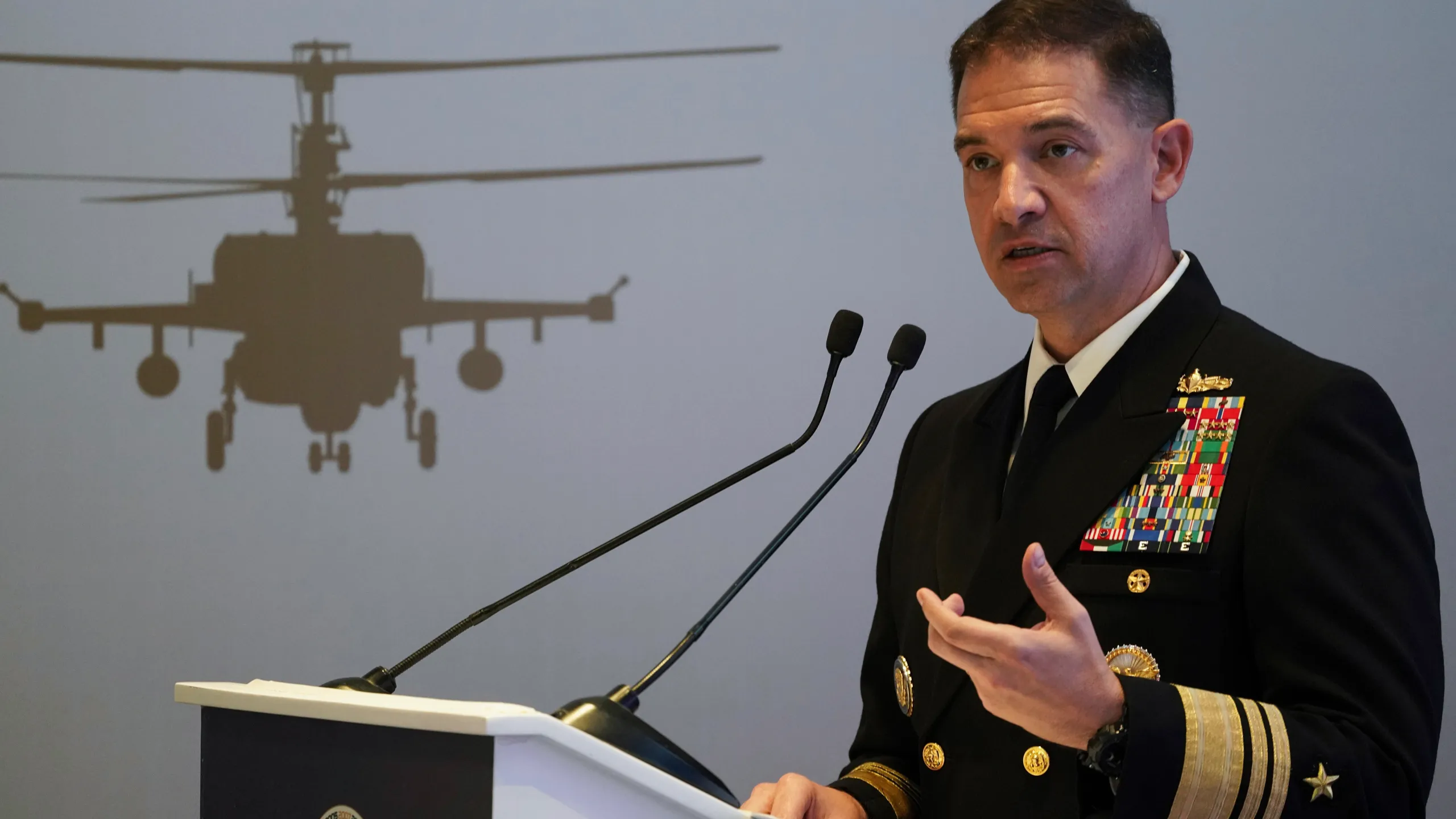
The US Navy’s operation against the Houthi rebels, overshadowed by the Israel-Hamas conflict in the Gaza Strip, has become the Navy’s most intensive ongoing sea fight since World War II, according to Navy officers and experts.
The conflict confronts the US Navy’s responsibility to keep international waterways open against a group whose old stockpile of assault rifles and pickup trucks has expanded into an almost limitless supply of drones, missiles, and other weaponry.
Since November, the Houthis have launched nearly daily strikes on more than 50 vessels, while shipping volume has plummeted in the critical Red Sea corridor that connects to the Suez Canal and the Mediterranean.
The Houthis claim the attacks are intended to end the fighting in Gaza and help the Palestinians, despite the fact that they are also attempting to bolster their position in Yemen. All indications are that the conflict will escalate, placing US sailors, friends, and commercial boats at risk.
The U.S. Navy prepared for decades to potentially fight the Soviet Union, then later Russia and China, on the world’s waterways. But instead of a global power, the Navy finds itself locked in combat with a shadowy, Iran-backed rebel group based in Yemen.
The U.S.-led campaign against the Houthi rebels, overshadowed by the Israel-Hamas war in the Gaza Strip, has turned into the most intense running sea battle the Navy has faced since World War II, its leaders and experts told The Associated Press.
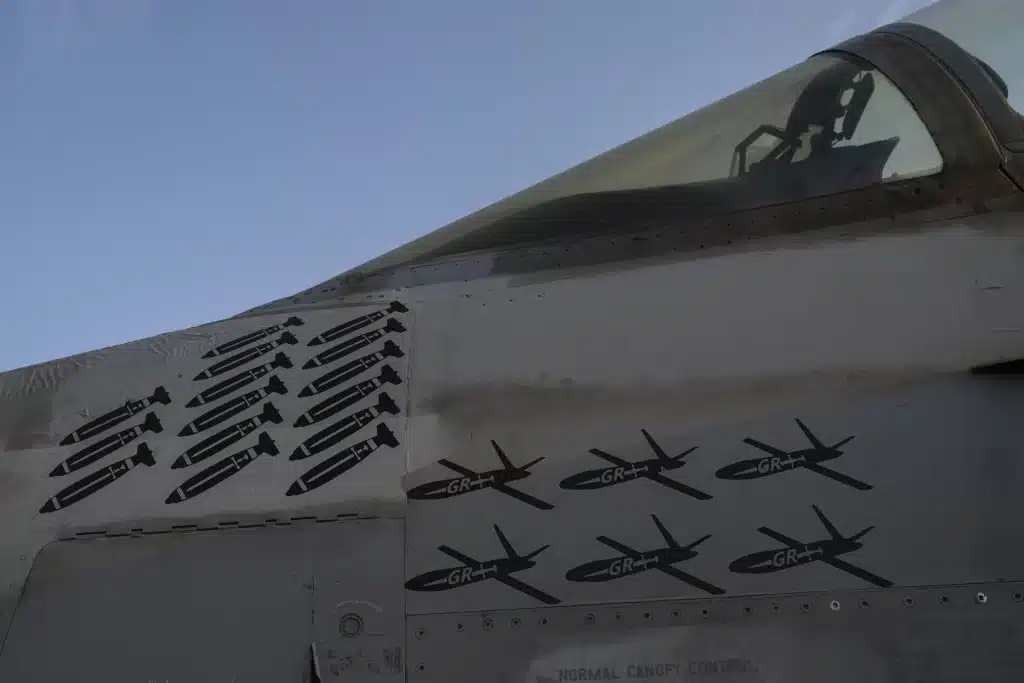
US Navy fighting Missiles and Drones
The combat pits the US Navy’s mission to keep international waterways open against a group whose former arsenal of assault rifles and pickup trucks has grown into a seemingly inexhaustible supply of drones, missiles and other weaponry.
Near-daily attacks by the Houthis since November have seen more than 50 vessels clearly targeted, while shipping volume has dropped in the vital Red Sea corridor that leads to the Suez Canal and into the Mediterranean.
The Houthis say the attacks are aimed at stopping the war in Gaza and supporting the Palestinians, though it comes as they try to strengthen their position in Yemen. All signs suggest the warfare will intensify — putting U.S. sailors, their allies and commercial vessels at more risk.
“I don’t think people really understand just kind of how deadly serious it is what we’re doing and how under threat the ships continue to be,” Cmdr. Eric Blomberg with the USS Laboon told the AP on a visit to his warship on the Red Sea.
“We only have to get it wrong once,” he said. “The Houthis just have to get one through.”
The pace of the fire can be seen on the Arleigh Burke-class destroyer, where the paint around the hatches of its missile pods has been burned away from repeated launches. Its sailors sometimes have seconds to confirm a launch by the Houthis, confer with other ships and open fire on an incoming missile barrage that can move near or beyond the speed of sound.
“It is every single day, every single watch, and some of our ships have been out here for seven-plus months doing that,” said Capt. David Wroe, the commodore overseeing the guided missile destroyers.
One round of fire on Jan. 9 saw the Laboon, other vessels and F/A-18s from the aircraft carrier USS Dwight D. Eisenhower shoot down 18 drones, two anti-ship cruise missiles and a ballistic missile launched by the Houthis.
Nearly every day — aside from a slowdown during the holy Muslim fasting month of Ramadan — the Houthis launch missiles, drones or some other type of attack in the Red Sea, the Gulf of Aden and the narrow Bab el-Mandeb Strait that connects the waterways and separates Africa from the Arabian Peninsula.
The Navy saw periods of combat during the “Tanker Wars” of the 1980s in the Persian Gulf, but that largely involved ships hitting mines. The Houthi assaults involve direct attacks on commercial vessels and warships.
“This is the most sustained combat that the U.S. Navy has seen since World War II — easily, no question,” said Bryan Clark, a former Navy submariner and a senior fellow at the Hudson Institute. “We’re sort of on the verge of the Houthis being able to mount the kinds of attacks that the U.S. can’t stop every time, and then we will start to see substantial damage. … If you let it fester, the Houthis are going to get to be a much more capable, competent, experienced force.”

Destroyer USS Laboon: AP Image
Dangers at sea and in the air
While the Eisenhower appears to largely stay at a distance, destroyers like the Laboon spend six out of seven days near or off Yemen — the “weapons engagement zone,” in Navy speak.
Sea combat in the Mideast remains risky, something the Navy knows well. In 1987, an Iraqi fighter jet fired missiles that struck the USS Stark, a frigate on patrol in the Persian Gulf during the Iran-Iraq war, killing 37 sailors and nearly sinking the vessel.
There’s also the USS Cole, targeted in 2000 by boat-borne al-Qaida suicide bombers during a refueling stop in Yemen’s port city of Aden, which killed 17 on board. AP journalists saw the Cole patrolling the Red Sea with the Laboon on Wednesday, the same day the Houthis launched a drone-boat attack against a commercial ship there that disabled the vessel.
That commercial ship was abandoned on Friday and left adrift and unlit in the Red Sea, the British military’s United Kingdom Maritime Trade Operations center said.
Rear Adm. Marc Miguez, the Navy’s commander for its Carrier Strike Group Two, which includes the Eisenhower and supporting ships, said the Navy had taken out one underwater bomb-carrying drone launched by the Houthis as well during the campaign.
“We currently have pretty high confidence that not only is Iran providing financial support, but they’re providing intelligence support,” Miguez said. “We know for a fact the Houthis have also gotten training to target maritime shipping and target U.S. warships.”
Asked if the Navy believed Iran picks targets for the Houthis, Miguez would only say there was “collaboration” between Tehran and the rebels. He also noted Iran continues to arm the Houthis, despite U.N. sanctions blocking weapons transfers to them.
Iran’s mission to the United Nations told the AP that Tehran “is adept at thwarting the U.S. strategy in a way that not only strengthens (the Houthis) but also ensures compliance with the pertinent resolutions.”
The risk isn’t just on the water. The U.S.-led campaign has carried out numerous airstrikes targeting Houthi positions inside Yemen, including what the U.S. military describes as radar stations, launch sites, arsenals and other locations. One round of U.S. and British strikes on May 30 killed at least 16 people, the deadliest attack acknowledged by the rebels.
The Eisenhower’s air crews have dropped over 350 bombs and fired 50 missiles at targets in the campaign, said Capt. Marvin Scott, who oversees all the air group’s aircraft. Meanwhile, the Houthis apparently have shot down multiple MQ-9 Reaper drones with surface-to-air missile systems.
“The Houthis also have surface-to-air capabilities that we have significantly degraded, but they are still present and still there,” Scott said. “We’re always prepared to be shot at by the Houthis.”
A stalemated war
Officers acknowledge some grumbling among their crew, wondering why the Navy doesn’t strike harder against the Houthis. The White House hasn’t discussed the Houthi campaign at the same level as negotiations over the Israel-Hamas war.
There are several likely reasons. The U.S. has been indirectly trying to lower tensions with Iran, particularly after Tehran launched a massive drone-and-missile attack on Israel and now enriches uranium closer than ever to weapons-grade levels.
Meanwhile, there’s the Houthis themselves. The rebel group has battled a Saudi-led coalition into a stalemate in a wider war that’s killed more than 150,000 people, including civilians, and created one of the world’s worst humanitarian disasters.
The U.S. directly fighting the Houthis is something the leaders of the Zaydi Shiite group likely want. Their motto long has been “God is the greatest; death to America; death to Israel; curse the Jews; victory to Islam.” Combating the U.S. and siding publicly with the Palestinians has some in the Mideast praising the rebels.
While the United States and its European allies police the waterways, Saudi Arabia has mainly been silent, seeking a peace settlement with the Houthis. According to reports, certain Middle Eastern countries have begged the United States not to initiate attacks on the Houthis from their territory, making Eisenhower’s presence even more crucial. The carrier’s deployment has been extended, and its crew has only made one port stop since its deployment a week after the October 7 Hamas attack on Israel.
Editors Note: Obama and Yemen
In 2015, US President Barack Obama began assisting a Saudi-led coalition against Houthi rebels in Yemen. The goal was to restore Yemen’s government, which the Houthis had deposed.
Obama approved logistical support, intelligence sharing, and weaponry sales to the coalition. Critics believe that this assistance exacerbated a humanitarian disaster, killing thousands of civilians and pushing millions to the edge of hunger.
Proponents argue that it was important to oppose Iranian influence in the region, given Tehran’s support for the Houthis. Despite objectives, the war has lingered on, causing enormous misery among Yemen’s people.
Middle East
Rescue Workers Search For Iran’s President After Helicopter Crash
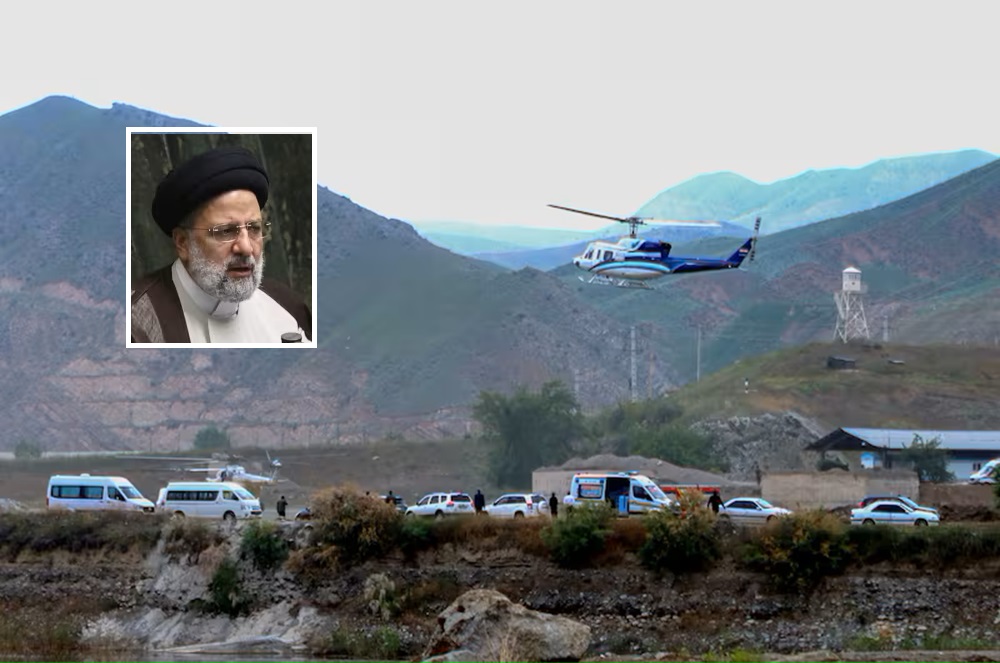
A helicopter carrying Iran’s President Ebrahim Raisi, the country’s foreign minister, and other dignitaries crashed in the mountainous northwest on Sunday, sparking a large rescue attempt in a foggy forest as the population was asked to pray.
The apparent crash occurred as Iran, led by Raisi and Supreme Leader Ayatollah Ali Khamenei, launched an unprecedented drone and missile offensive on Israel last month and enriched uranium closer than ever to weapons-grade levels.
Iran has also endured years of large protests against its Shiite theocracy over an ailing economy and women’s rights, making the situation even more sensitive for Tehran and the country’s future as the Israel-Hamas conflict rages across the Middle East.
Raisi was heading through Iran’s East Azerbaijan province. State television reported a “hard landing” at Jolfa, a city on the border with Azerbaijan some 600 kilometers (375 miles) northwest of Tehran. Later, state television moved it farther east, near the hamlet of Uzi, but reports remained inconsistent.
Iranian Foreign Minister Hossein Amirabdollahian, the governor of Iran’s East Azerbaijan region, and other officials and bodyguards accompanied Raisi, according to the Associated Press. One local government official used the term “crash,” while others mentioned a “hard landing” or a “incident.”
Iran’s state TV Silent
In the hours that followed, neither IRNA nor state TV reported on Raisi’s condition. However, hardliners urged the population to pray for him. State television broadcast footage of hundreds of believers, some with their hands raised in supplication, worshiping at the Imam Reza Shrine in Mashhad.
One of Shiite Islam’s holiest shrines, as well as in Qom and other cities across the country. The primary channel of state television broadcast the prayers nonstop. In Tehran, a group of men kneeling on the side of the street held strands of prayer beads and watched a video of Raisi praying, with some clearly crying.
“If anything happens to him, we’ll be heartbroken,” one of the men, Mehdi Seyedi, stated. “May the prayers work and may he return to the arms of the nation safe and sound.”
Interior Minister Ahmad Vahidi stated on state television that “the esteemed president and company were on their way back aboard some helicopters, and one of the helicopters was forced to make a hard landing due to bad weather and fog.”
“Various rescue teams are on their way to the region but because of the poor weather and fogginess it might take time for them to reach the helicopter.”
Poor weather conditions
IRNA referred to the area as a “forest,” and it is also known to be mountainous. Poor weather conditions, including heavy rain and wind, hampered SUVs racing through a wooded region, according to state TV. Rescuers were visible walking through the fog and mist.
A rescue aircraft attempted to land in the region where authorities believe Raisi’s chopper was, but was unable to do so owing to heavy mist, emergency services spokesperson Babak Yektaparast told IRNA.
Late in the evening, Turkey’s defense ministry reported that it had sent an unmanned aerial vehicle and was prepared to send a helicopter with night vision capabilities to assist with the search and rescue efforts.
Long after the sun had set, Iranian government spokesman Ali Bahadori Jahromi said that “we are experiencing difficult and complicated conditions” throughout the search.
Raisi, 63, a hardliner who formerly commanded the country’s court, is seen as Khamenei’s protégé, and some observers believe he may succeed the 85-year-old leader after his death or retirement. Raisi had gone on the border with Azerbaijan early Sunday to inaugurate a dam alongside President Ilham Aliyev. The dam is the third that the two countries have built on the Aras River.
The visit occurred despite strained relations between the two countries, including a shooting attempt on Azerbaijan’s Embassy in Tehran in 2023 and Azerbaijan’s diplomatic connections with Israel, which Iran’s Shiite theocracy regards as its principal regional adversary.
Iran pilots a variety of helicopters, but international sanctions make it difficult to obtain spare parts. Its military air fleet predates the 1979 Islamic Revolution. IRNA reported images showing Raisi taking off in what seemed to be a Bell helicopter with a blue-and-white paint scheme similar to that seen in prior photographs.
Raisi won Iran’s 2021 presidential election, which had the lowest turnout in the Islamic Republic’s history. The US has sanctioned Raisi in part because of his involvement in the mass execution of thousands of political detainees in 1988, at the close of the horrific Iran-Iraq war.
Source: AP
Middle East
Iraq Bans Same-Sex Relations and Transgenderism
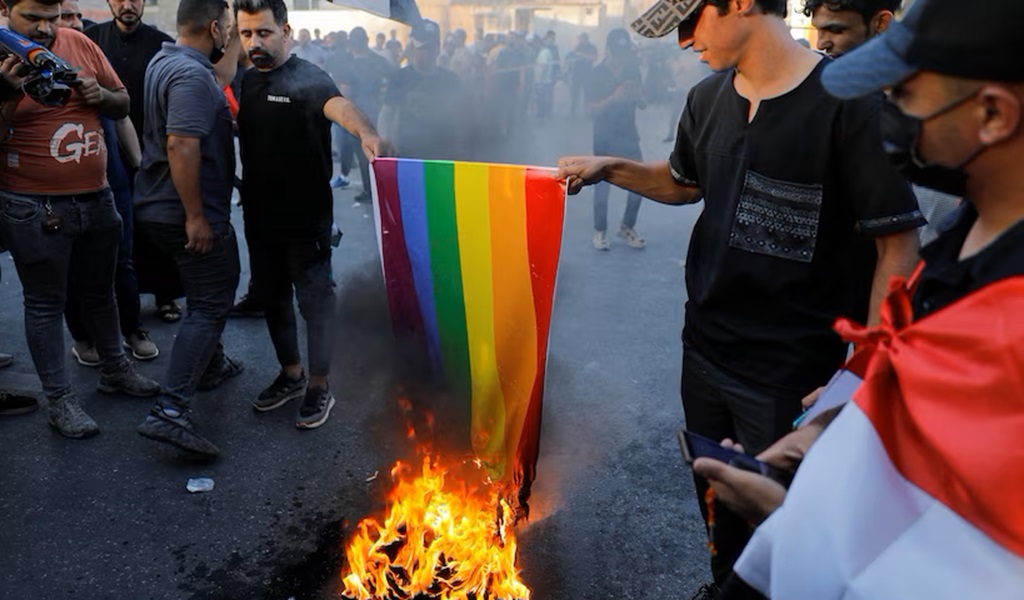
Iraq’s parliament has passed legislation prohibiting same-sex relationships and transgenderism. The US and UK opposed the move, but the speaker of the parliament defended it as “a necessary step to protect the value structure of society.”
On Saturday, the legislature enacted an amended law combating prostitution and homosexuality.
According to a copy of the law obtained by RT, anyone engaging in homosexual relations faces prison sentences of 10-15 years, seven years for anyone who promotes homosexuality or prostitution, and one to three years for anyone who changes their “biological gender” or dresses effeminately.
Acting Iraqi parliamentary speaker Mohsen Al-Mandalawi said in a statement that enacting the measure was “a necessary step to protect the value structure of society” and “protect our children from calls for moral depravity and homosexuality.”
The Iraqi legal code of 1969 did not officially punish homosexuality, but it did not protect gays and lesbians from extrajudicial persecution.
An modification to the law in the 1980s permitted the ‘honor killing’ of gays by their family members, while a 1993 amendment to the constitution established the death sentence for homosexual behavior.
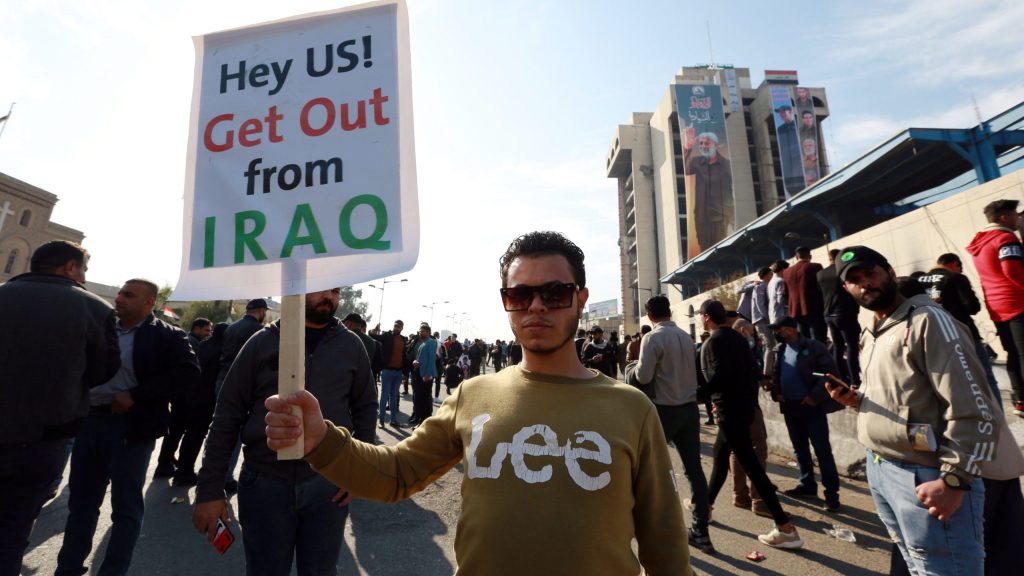
The withdrawal of US troops from Iraq : Getty Image
Western media outlets reported an increase in police and militia attacks on homosexuals following the partial withdrawal of American soldiers in 2012, despite the US State Department’s declaration in 2019 that it had taught Iraqi security personnel “on the proper observance of human rights.”
According to a press release from State Department spokesperson Matthew Miller, the United States is “deeply concerned” about Saturday’s vote. “This amendment threatens those most at risk in Iraqi society and weakens Iraq’s ability to diversify its economy and attract foreign investment,” he said.
In a social media post, British Foreign Secretary David Cameron described the bill as “dangerous and worrying,” adding that “no one should be targeted for who they are.”
Homosexuality, regardless of its legal position, has long been considered taboo within Iraq’s traditional Shia majority. Some Iraqis view LGBTQ culture as a hostile Western ideology, and rainbow-colored ‘Pride’ banners are occasionally burned alongside Western flags at Iraqi protests.
According to Wikipedia, lesbian, gay, bisexual, and transgender (LGBT) people have limited or severely restricted rights in most parts of the Middle East, and they face hostility in others. In nine of the region’s 18 countries, sex between men is outlawed.
It is punishable by death in four of the 18 countries. The cultural traditions and religious mores of individuals residing in the region, particularly Islam, have a profound influence on the rights and freedoms of LGBT citizens.

Same-sex relations and transgenderism: File Image
Same-sex activity is legal in Cyprus, Northern Cyprus, Israel, Jordan, and Turkey. Male same-sex activity is prohibited and punishable by imprisonment in Kuwait, Egypt, Oman, Syria, and the UAE. It is also punishable by death in Iran, Saudi Arabia, and Qatar.
Depending on the crime, the punishment in Yemen and the Gaza Strip could range from death to jail.
In Iran, Saudi Arabia, Qatar, and Yemen, if a person is found guilty of same-sex sexual conduct, they face the death penalty. The US Department of State’s Country Reports show that there are no established LGBT organizations in Saudi Arabia.
Furthermore, claims of governmental and social discrimination on the basis of sexual orientation are ambiguous due to significant social pressure not to discuss LGBT issues.
Homosexuality is not legally criminal in Iraq, but LGBT people can face charges under public indecency legislation 401.
Which punishes anything considered harmful to public decency or morality with up to six months in jail and a fine. Vigilantes and Sharia courts also execute them, beat them, torment them, and attack them.
Jordan and Bahrain are the only Arab countries where homosexuality is legal; nonetheless, numerous Middle Eastern states tolerate and defend transsexual and transgender people.
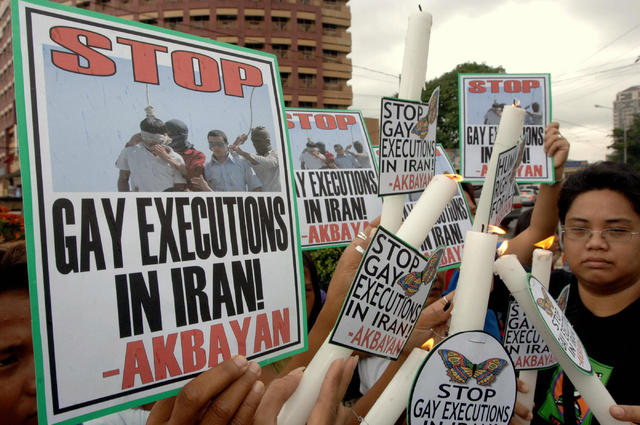
Iran purportedly executes 2 gay men: Image CBS
For example, the Iranian government has permitted sex change procedures with medical approval. The Syrian government approved similar operations in 2011. LGBT rights movements have existed in various Middle Eastern countries, such as Turkey and Lebanon.
However, progress has been gradual in both Turkey and Lebanon, and a recent crackdown on LGBT-related activities has raised worries about LGBT people’s and organizations’ freedom of association and speech.
Israel is a significant exception, as it is the most supportive of LGBT rights and allows unregistered cohabitation. Israel likewise permits transgender people to legally alter their gender without surgery. Transgender people can openly serve in the Israeli Defense Forces.
Before globalization, Middle Eastern men and women who had homosexual relationships did not consider themselves ‘homosexual’.
The concept of “homosexuality” was brought to Middle Eastern regions as a result of Western-Middle Eastern interactions, and these individuals were then pushed to link themselves with new labels such as “gay”, “lesbian”, “straight”, and so on. Before the usage of these labels, people did not categorize their sexuality in this manner.
Iraq Government Labels Homosexuals as Sexual Deviants
-

 News3 years ago
News3 years agoLet’s Know About Ultra High Net Worth Individual
-
Entertainment2 years ago
Mabelle Prior: The Voice of Hope, Resilience, and Diversity Inspiring Generations
-

 Health3 years ago
Health3 years agoHow Much Ivermectin Should You Take?
-

 Tech2 years ago
Tech2 years agoTop Forex Brokers of 2023: Reviews and Analysis for Successful Trading
-

 Lifestyles3 years ago
Lifestyles3 years agoAries Soulmate Signs
-

 Movies2 years ago
Movies2 years agoWhat Should I Do If Disney Plus Keeps Logging Me Out of TV?
-

 Health3 years ago
Health3 years agoCan I Buy Ivermectin Without A Prescription in the USA?
-

 Learning2 years ago
Learning2 years agoVirtual Numbers: What Are They For?
